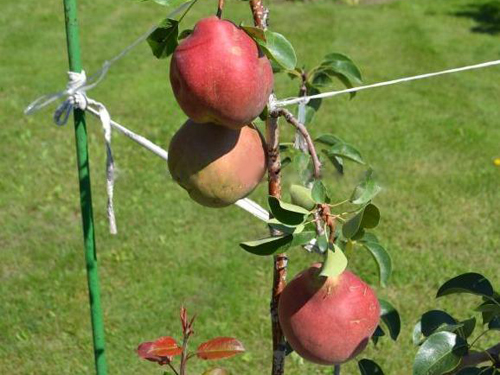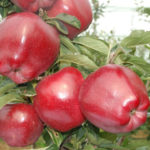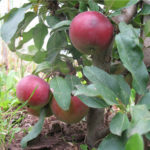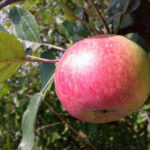Pear variety Quiet Don
A pear variety with a name that caresses the ear Tikhy Don is a wonderful fruit of the labor of the famous breeder Anna Ulyanishcheva, one of the leading researchers of the Rossoshansk zonal experimental gardening station located in the Voronezh region. Our heroine was obtained as a result of hybridization of varieties Marble and Rossoshanskaya beautiful, with the subsequent selection of the best seedling. The characteristics of the new product turned out to be so impressive that it passed the state variety test without any problems, was entered into the State Register of Breeding Achievements of the Russian Federation and was recommended for industrial cultivation in the Central Black Earth Region of the country.
Amateur gardeners also appreciated the many advantages of our heroine. First of all, they include the high resistance of the variety to a very harmful disease - scab, excellent productivity and large fruit size, early fruiting, excellent taste and presentation of the fruit, as well as the relative compactness of the tree, which makes it easier to care for it. The disadvantages can be counted very few (in particular, the susceptibility of pears to tartar and septoria), and they are easily correctable. Thanks to this, Quiet Don is today a welcome guest on many garden and garden plots, and even in farm plantings.

Agrobiological characteristics
Trees show moderate vigor. At the age of 10, they usually do not exceed three meters in height. The crown of a pear is characterized as rounded, although it may be somewhat drooping. The density of the branches is average. The bark on the trunk is gray, and on the large branches it is grayish-brown. Skeletal branches are inclined vertically. Fruiting occurs on sessile ringlets located on 2-3 annual branches.
The shoots of the variety are long, straight, brown-red in color, medium or thick in diameter, rounded in cross section, without pubescence. The length of internodes is average, the buds are brown, cone-shaped, somewhat protruding. The leaves are medium-sized with an ovoid outline, dark green. The surface of the leaf blade is leathery, glossy; profile - curved upwards; pubescence is absent. The serration of the leaf is small-town. The length and thickness of the petioles are moderate.
The flowers are medium in size, saucer-cupped, collected in clusters of 8 or more pieces. The color of the petals is white, they themselves are closed, whole-edged. Pubescence of the pistil column is not observed; the anthers are located on the same plane with the stigma. The variety needs to be planted nearby pollinators with a similar flowering period. Dessert Rossoshanskaya or Marble pears show good results in this regard. Blooming of the flowers of the Quiet Don occurs in the medium term, and therefore the risk of damage by late spring frosts is at the usual level.
The fruits of this variety grow massive, fairly uniform in size, oval, or have the shape of a regular blunt-pointed cone. They hang on thick stalks of medium length. There is no funnel at the base of the peduncle; instead, a small influx is often observed in this place. The attractiveness of the appearance is estimated at 5 points. The weight of the harvested pears ranges from 250 to 350 grams. The surface of the fruit is smooth, greenish-yellow in color with a reddish blush, blurred over a large area. The cup can be either closed or half-open. The sub-cup tube is small. The saucer is shallow, moderately wide, folded type. Seeds are brown in color, elongated in length. The skin is thick, but chewable; under the skin, many small green dots are noticeable. The consistency of the pulp is tender, juicy-oily, fine-grained; density - moderate; color - light cream. The taste is dessert, sweet, sometimes with a barely noticeable sourness. The aroma is typical for the culture, its intensity is medium.The sugar content of fruits reaches 11-12%, with the sum of acids 0.15-0.20%. In general, the taste characteristics are beyond praise; they are rated at 4.8 points during tasting.
Ripening, depending on climatic conditions, occurs from early to mid-September, in connection with which Tikhy Don belongs to autumn hybrids. The harvested pear harvest reaches its best consumer properties by the end of September, and shows good keeping quality for two to three months, provided that an optimal microclimate in the store is provided. The fruits, excellent from a gastronomic point of view, are used mainly fresh, but at the same time they are excellent for processing into compotes and jam. They also carry long-distance transportation painlessly, so that the possibilities of marketing the crop are not limited to the local market.
The variety resists unfavorable environmental factors well. In particular, trees tolerate dry periods well, with no decrease in fruit size or shedding. High resistance rates are also observed in relation to winter frosts. In the regions where the variety is zoned, slight freezing is observed only in the coldest winters, and cases of plant death from low temperatures have not been recorded at all.
Productivity is more than decent - more than 50 kg of marketable pear can be harvested from a ten-year-old tree, and in industrial plantings, yields can reach 300 or more centners per hectare. Fruiting usually occurs in the fourth or fifth year after planting.
Agrotechnical features
Due to the high economic qualities of the Quiet Don, caring for the variety does not threaten to be too difficult, and in many respects will correspond to the standard approaches to the cultivation of this crop.
The placement of the garden should take place in suitable soil and climatic conditions: on sufficiently fertile, well-structured, air-permeable lands, with an acceptable level of heat, moisture and sunlight. Excessively damp, wetlands and areas with a high level of groundwater are not intended for the establishment of perennial plantations. Salinity of the soil, its strong acidity or alkalinity are also a contraindication to planting pears.
The feeding area of medium-sized trees should be at least 15-16 sq. meters, and planting density 550-650 seedlings per hectare. The land must be well prepared, the planting holes must be dug of sufficient volume and well filled with mineral and organic fertilizers, which will ensure the rapid growth and development of the young garden. The planting procedure is preferably carried out in the fall, after the leaves have fallen from the seedlings, but it is possible in the spring, as soon as possible, to go out into the field.
From the very first season, one should start performing the formative pruning of the Quiet Don, which will continue annually, until the beginning of fruiting of the variety. At this stage, it is important to form the correct crown of the trees with several levels of skeletal branches extending from the central conductor at an optimal angle. After the beginning of the productive period, the purpose of pruning becomes, first of all, to obtain a high yield and to prevent periodicity in pear fruiting. However, at this time, one should not forget about the need to maintain vegetative activity, which is expressed in sufficient annual shoot growth. In mature trees, excessive exposing of the branches should be avoided, timely rejuvenating them.
Depending on the local climate, the soil under the trees is kept either by completely removing vegetation, or by sowing the aisles with perennial grasses, which will be periodically mowed and serve as mulch.The advantage of the first option is the rational use of soil moisture, which is especially important in regions where it is deficient. The downside is the gradual destruction of the soil structure and the inevitable decrease in its fertility. The second approach not only eliminates these disadvantages, but also contributes to the accumulation of humus in the soil, but is applicable only in areas with sufficient moisture.
To combat fungal diseases, the Quiet Don will only need preventive spraying with fungicides, which can be combined with insecticidal pear treatments against pests before and after flowering.








